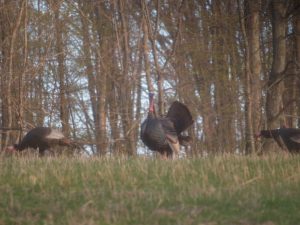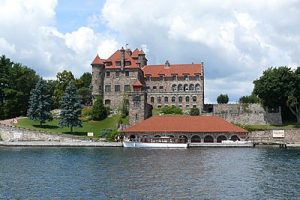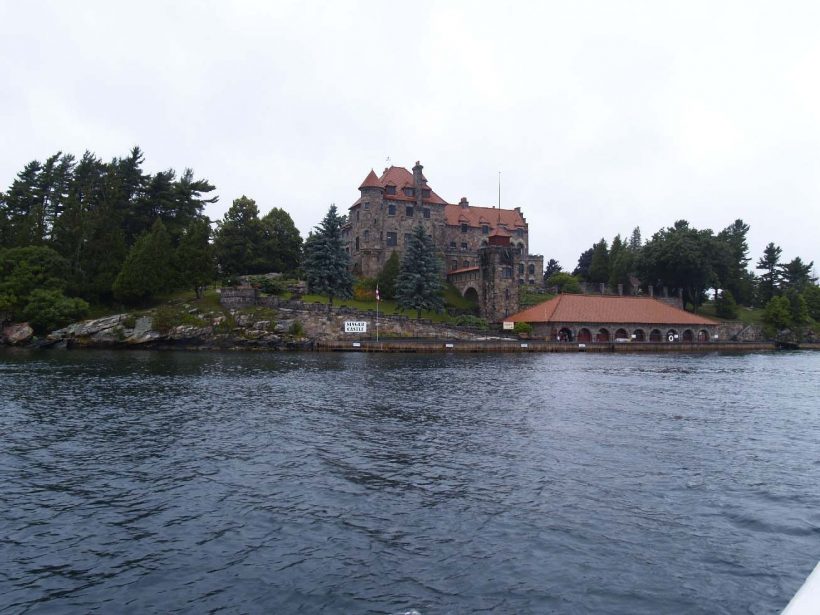THE TIMES TRAVELLER by BARNEY MOORHOUSE For Reproduction Rights call Access 1-800-893-5777
SINGER CASTLE
Quickie Quiz. Multiple Choice. At any given time, the building in the accompanying photo was: a) a castle (beware the obvious) b) a fishing camp c) a hunting lodge d) a religious retreat?
Crossing at the Ivy lee Bridge, we entered the U.S. on our way to Schermerhorn Harbor. There we met Ken Belfield who piloted us to Dark Island on one of Uncle Sam’s Boats. Dark Island, first known as Lone Star by the Indians (according to Andrew, one of our two guides) is located on the American side of the St. Lawrence. The New York Times, on September 10, 1905, described it as a “darkling hulk against the background of the sunlit river,” for it was heavily covered by pines and bush.
Frederick G. Bourne (1851-1919), the son of a preacher man, befriended the son of the president of the Singer Sewing Machine Company while singing in the church choir. Eventually, working for the company, Bourne became its fourth president. Under Bourne Singer expanded throughout the world and he became one of the wealthiest Americans. An avid sportsman Bourne wanted a hunting and fishing lodge and so he purchased Dark Island and commissioned architect friend Ernest Flagg to design the lodge. Flagg fashioned it after a mysterious castle in one of Sir Walter Scott’s novels, Woodstock, where the ousted King Charles 1 sought protection from the independents led by Sir Oliver Cromwell.
At a cost of $500,000, construction went on year round from 1903 to 1905. The entire castle and other buildings were estimated to cost $4 million to build or approximately $40 million by today’s costs. According to guide Andrew the workers had to camp out in tents during the winter. Corn Island, on the Canadian side of the river, came with the dark Island purchase. In the course of construction 2000 loads of soil were transferred from Ontario to Dark Island. This prompted the New York Times to quip: “This is probably the first and greatest actual ‘annexation’ of Canada ever achieved by the United States.” Not everyone was enamored with the undertaking. Frederic Remington, the famous Wild West artist, lived on a nearby island and apparently wasn’t pleased as it “spoiled the neighborhood.” However, upon completion, the artist apparently sent a bouquet of flowers with a congratulatory message.

Singer Castle became the Bourne’s summer home and hunting lodge featuring 28 rooms and 13 fireplaces. The Trophy room features moose, caribou, deer and elk that were hunted in Canada. Apparently game such as rabbit, grouse and turkey were turned loose on the six acre island for upland hunting while Bourne also favoured water fowling. A portrait of Charles 1 is actually the front to one of the many secret passageways that honeycomb throughout the castle. The portrait, once altered, permits unseen eyes to view the room. Secret doors were found in the Library panels, closets and the wine cellar. During prohibition Bourne’s daughter Marjorie kept the door to the wine cellar locked saying it was just a closet. But the servants (Mr. Bourne had some 30-40) could access the wine cellar from a secret passageway that led both to the kitchen and the Library. (Guide Andrew suggested that this was designed by a college student.) Guide Sarah added that during prohibition Bourne would send trusted servants under the cloak of darkness to Corn Island to pick up his wine. “They would fill some crates with salt and place the wine on top. If they had to throw the crates overboard they would sink.” Once the salt dissolved the crates would float to the surface for retrieval. Sarah also mentioned that a Butler and maid were caught kissing for which both were fired. Presently married, both are in their 90’s, and living in Florida. One of the castle managers paid them a visit and discovered much of the castle’s colourful history as related during the tour. Andrew said that it was not the custom of Mr. Bourne and his wife to share the same bed, let alone the same bedroom so one might appreciate the seriousness of the kissing incident.

An Italian craftsman, working on a marble fireplace, saw the reflection of a ghost in the mirror above the mantel. Alarming his fellow countrymen they wanted off the “haunted” island. Mr. Bourne had to explain to them that the “ghost” was someone passing through a secret passageway. Servants would sit and observe guests at dinner through this portal high on the western wall. They could determine, by observing the facial expressions, if the guests were enjoying the meal and also when to send in the next course.
Andrew said that at least one lady on tour asked if the Bournes had dogs. Dogs were not mentioned and Andrew responded in the affirmative and asked the reason for the question. “I saw the silhouette of a dog on one of the beds,” she replied. Could there be a ghost dog? “We’ve never seen ghosts,” he added. “It’s just fun to think about them.” The resident caretaker apparently also has no belief that there are any ghosts.
The secret passageways, by the way, were to allow the servants to move about carrying out their duties without infringing upon the many guests who stayed at Singer Castle. Due to the size of the passageways one can presume the servants would be wiry, slight and in keeping with the times, short. Today such people would be less commonly available.

Bourne’s daughter, Marjorie, eventually took over the lodge. She was an accomplished athlete and somewhat independent as evidenced by the fact that she only had four personal servants including a doctor, hairdresser, and a masseuse. In the shower room was what may be the forerunner of today’s tanning machines. A person would sit in an enclosed box that contained several light bulbs and a bucket of water. Only the person’s head could be seen. Awareness that the combination of electricity and water make for a deadly mix abruptly ended its popularity. In one of the many bathrooms an electrical panel just above a bathtub indicates that safety standards weren’t as current as to-day. Marjorie had a squash court made entirely of maple for her husband Alexander’s birthday.
During the tour with castle Manager Tom Weldon we took in the extended tour which is available for those who stay the night. Weldon explained that although they have no historical evidence they think that the electrical system for the island was designed by Thomas Edison. The huge generators would store electrical energy in submarine batteries which then provided the island with a 12 volt system. The castle also had indoor plumbing and a telephone system. By dialing two digits the operator could connect the caller to any room in the castle. A 500 gallon holding tank in the tower provided the castle’s water needs via a gravity feed system. The present water system employs chlorination; a couple of ultra violet light systems and the water quality is tested twice a month. “What we put back into the St. Lawrence is cleaner than what we take out,” said Weldon.
Before heading to the gift shop to view a video featuring the history of Singer Castle, Weldon took us into the clock room to learn about the unique self-winding clock designed by the E. Howard Clock Company, one of the first to make electric clocks at the beginning of the 20th century. It was installed in the late 1920’s and was made with Westminster chimes. Each of the four wrought-iron clock faces measures 12 feet in circumference.
While waiting for our boat for the return journey a freighter passed closely to the island sending out a large wake. Dark Island is adjacent to the shipping lanes. Weldon says that the ships still require special river pilots to navigate the St. Lawrence.

Cones
Did you know that the ice cream cone was introduced at the St. Louis World Fair in 1904? There is a connection to Singer Castle and if you take the tour you’ll discover the answer. (Clue- It’s in the Library.) Speaking of which – the answer to the Quickie Quiz is (f) – all of the above. The religious connection? Another reason to take the tour. For more information call 1.877.327.5475 or goto: www.singercastle.com.
CANUCKIANA
Singer Castle does host weddings. One groom promised to get married at the castle IF he could go fishing after the ceremony. “He had all his fishing tackle ready to go,” said Weldon.
